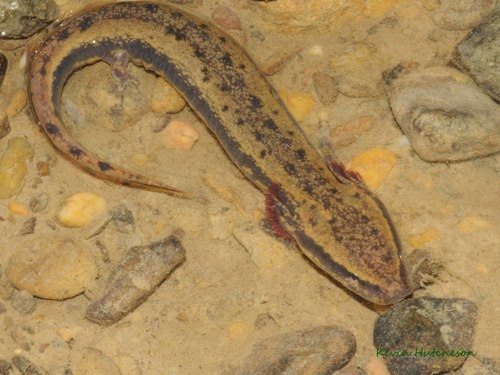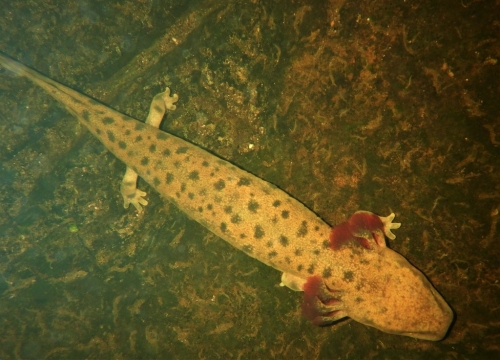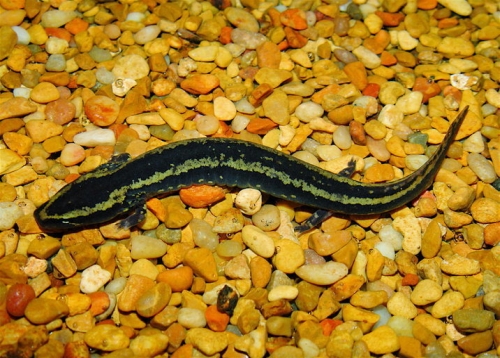Plants and Animals
Necturus maculosus Mudpuppy
Key Characteristics
The Mudpuppy is a large aquatic salamander with adult lengths of 20.3 to 48.2 cm (8-19 in). It has a broad, flat head with small eyes, a dark stripe through each eye (which sometimes extends down the side of the body), two gill slits, and large, bushy, red- or maroon-colored external gills behind the head. The body and tail are generally rusty brown to gray or black with scattered bluish-black spots or blotches (sometimes merging to form stripes). The underside is usually white, pale gray, yellow or brown, sometimes with dark spots. The tail is vertically flattened, and there are four toes on each limb. Hatchlings and juveniles smaller than 12.7 to 15.2 cm (5-6 in) are generally black with a yellow- or cream-colored stripe running down each side of the body or back from the nose to the tip of the tail. Adult males and females look similar except that males have swollen cloaca during the breeding season and two prominent backward-pointing papillae or protrusions behind the vent. Mudpuppies have slimy skins and no scales.
Status and Rank
US Status: No Status/Not Listed
State Status: SC - Special Concern (rare or uncertain; not legally protected)
Global Rank: G5 - Secure
State Rank: S3S4 - Rank is uncertain, ranging from vulnerable to apparently secure
Occurrences
| County | Number of Occurrences | Year Last Observed |
|---|---|---|
| Alcona | 1 | 1998 |
| Alger | 13 | 2019 |
| Allegan | 7 | 2015 |
| Alpena | 5 | 2012 |
| Antrim | 7 | 2015 |
| Arenac | 5 | 2018 |
| Baraga | 4 | 2017 |
| Barry | 4 | 2021 |
| Benzie | 2 | 2012 |
| Berrien | 8 | 2009 |
| Branch | 1 | 2005 |
| Calhoun | 3 | 2010 |
| Charlevoix | 2 | 2021 |
| Cheboygan | 6 | 2024 |
| Chippewa | 18 | 2017 |
| Clare | 1 | 1997 |
| Clinton | 1 | 2010 |
| Crawford | 2 | 2022 |
| Delta | 12 | 2017 |
| Dickinson | 4 | 2010 |
| Emmet | 3 | 2021 |
| Genesee | 2 | 2018 |
| Gladwin | 1 | 2008 |
| Gogebic | 3 | 2009 |
| Gratiot | 2 | 2010 |
| Hillsdale | 2 | 2021 |
| Houghton | 2 | 2017 |
| Huron | 1 | 2010 |
| Ingham | 1 | 2010 |
| Iosco | 12 | 2018 |
| Isabella | 5 | 2012 |
| Jackson | 6 | 2021 |
| Kalamazoo | 3 | 2021 |
| Kalkaska | 2 | 2019 |
| Kent | 2 | 1992 |
| Lake | 1 | 2011 |
| Leelanau | 8 | 2019 |
| Lenawee | 4 | 2017 |
| Livingston | 8 | 2020 |
| Luce | 4 | 2013 |
| Mackinac | 14 | 2013 |
| Macomb | 2 | 2021 |
| Manistee | 5 | 2019 |
| Marquette | 9 | 2010 |
| Mason | 5 | 2020 |
| Mecosta | 1 | 2009 |
| Menominee | 7 | 2013 |
| Midland | 6 | 1999 |
| Monroe | 2 | 2021 |
| Montcalm | 5 | 2018 |
| Montmorency | 2 | 2015 |
| Muskegon | 3 | 2021 |
| Newaygo | 3 | 2013 |
| Oakland | 6 | 2020 |
| Oceana | 4 | 2013 |
| Ogemaw | 5 | 2020 |
| Ontonagon | 2 | 2013 |
| Oscoda | 2 | 2015 |
| Otsego | 1 | 2019 |
| Presque Isle | 7 | 2013 |
| Roscommon | 2 | 2022 |
| Saginaw | 4 | 2008 |
| Sanilac | 2 | 2009 |
| Schoolcraft | 10 | 2021 |
| Shiawassee | 1 | 2009 |
| St. Clair | 4 | 2021 |
| St. Joseph | 4 | 2010 |
| Tuscola | 1 | 2012 |
| Van Buren | 3 | 2009 |
| Washtenaw | 11 | 2020 |
| Wayne | 3 | 2021 |
Information is summarized from MNFI's database of rare species and community occurrences. Data may not reflect true distribution since much of the state has not been thoroughly surveyed.
Habitat
Mudpuppies live in permanent waters including rivers, perennial streams, ponds, inland lakes, Great Lakes bays and shallows, reservoirs, canals, and ditches. They prefer medium to large rivers and lakes, and aquatic habitats with abundant shelter or cover, such as riprap, talus, boulder/rock piles, rocks, especially flat rock slabs, large submerged logs or woody debris, dense mats of submergent vegetation, eroded or undercut banks, and tree roots. They inhabit clear and silty waters and areas with or without aquatic vegetation. Mudpuppies are rarely seen, hiding under rocks or other cover objects during the day and becoming active only at night, especially in clear water, or being active both day and night in habitats with shallow water and thick aquatic vegetation. They typically move to shallower water in the spring and move to deeper water in the summer and winter (e.g., as deep as 56 ft in Lake Erie and 100 ft in Lake Michigan). Mudpuppies primarily walk on the bottom of rivers and lakes but they can also swim through the water column. Young mudpuppies may use separate habitats from adults, frequently occurring in densely vegetated shallow water areas along the edges of lakes and streams.
Natural Community Types
- Great lake, littoral, benthic
- Great lake, pelagic, benthic
- Great lake, pelagic, midwater
- Inland lake, littoral, benthic
- Inland lake, pelagic, benthic
- Inland lake, pelagic, midwater
- Mainstem stream (3rd-4th order), pool
- Mainstem stream (3rd-4th order), run
- Mainstem stream (3rd-4th order), riffle
- River (5th-6th order), pool
- River (5th-6th order), run
- River (5th-6th order), riffle
For each species, lists of natural communities were derived from review of the nearly 6,500 element occurrences in the MNFI database, in addition to herbarium label data for some taxa. In most cases, at least one specimen record exists for each listed natural community. For certain taxa, especially poorly collected or extirpated species of prairie and savanna habitats, natural community lists were derived from inferences from collection sites and habitat preferences in immediately adjacent states (particularly Indiana and Illinois). Natural communities are not listed for those species documented only from altered or ruderal habitats in Michigan, especially for taxa that occur in a variety of habitats outside of the state.
Natural communities are not listed in order of frequency of occurrence, but are rather derived from the full set of natural communities, organized by Ecological Group. In many cases, the general habitat descriptions should provide greater clarity and direction to the surveyor. In future versions of the Rare Species Explorer, we hope to incorporate natural community fidelity ranks for each taxon.
Management Recommendations
Maintaining and protecting existing populations, particularly those with larger population sizes and successful recruitment, will help sustain the species in perpetuity. Captive rearing and introducing young mudpuppies may be needed to augment some populations. Improving water quality and reducing chemical contamination and siltation from agricultural, industrial and residential practices in occupied habitats would improve health and survival of mudpuppies since they are highly vulnerable to pollutants and decreased water quality. Limiting the use of lampricide for controlling sea lampreys and limiting algal blooms and botulism outbreaks in occupied sites would reduce mass mortality of mudpuppies. Controlling invasive species, such as zebra mussels and Eurasian watermilfoil, would help mitigate changes to aquatic communities caused by these species and benefit mudpuppy populations. Mass collection and overharvesting of mudpuppies for bait and by biological supply companies should be discontinued. Education and outreach are needed to raise awareness and reduce misunderstanding and persecution by anglers. The slippery skin of mudpuppies and the incorrect assumption that they are poisonous and detrimental to game fish populations may lead uninformed anglers to cut their lines or cast mudpuppies aside to die rather than unhook them. . Additional surveys and research are needed to identify priority populations in the state and obtain information on their status, viability, and site-specific ecology and threats to inform and implement effective conservation measures. It also is critical to protect this species because it is the only host of the state threatened Salamander Mussel (Simpsonaias ambigua).
Active Period
Active from first week of January to fourth week of December
Breeding from third week of September to fourth week of November
Spawning from fourth week of May to fourth week of June
Survey Methods
Surveys can be conducted during any time of year since mudpuppies are active year-round. However, the effectiveness of different survey methods varies depending on the time of year and type of habitat. Trapping using modified steel minnow traps is effective in deep and turbid water and in late fall through early spring (i.e., November-late March/early April) when water temperatures are cooler (e.g., below 41°F or 64°F depending on the study). Modified “Briggler traps” which are box traps constructed of aluminum and plastic mesh that have been used for hellbender surveys also have been found to be effective. Large number of trap nights are recommended as capture rates tend to be low. Manual surveys, which consist of wading or floating upstream while overturning large flat rocks under which mudpuppies may be hiding, are effective in clear, shallow water conditions and in late summer and early fall during warmer water temperatures. Seining works best in debris-laden (e.g., leaf litter) streams and rivers that are absent of large flat rocks. This survey method consists of dragging a seine net through a river or stream with at least one person disturbing debris, rock piles and other cover ahead of the seine in order to dislodge mudpuppies from their habitats on the bottom of the streams. Electroshocking works well in areas with few rocks and high conductivity but has drawbacks as well. Other less common survey methods, typically used to sample for fish, include fish trapnets, set lines, fyke nets, cement anchors, and eggmats. Additionally, trapping with minnow traps and set lines tend to capture large adults and/or larger juveniles. Manual surveys and seining seem to be more effective at capturing smaller individuals and juvenile and larval mudpuppies.
Trapping with aquatic traps
Survey Period: From first week of November to first week of April
Water Temperature: Cold
Water Level: High Water Levels
Water Turbidity: Low Turbidity
Survey Method Comment: Trapping with modified steel minnow traps or modified box traps used for surveying hellbenders in deep and turbid water and when water temperatures are cooler (e.g., <41°F or 64°F) have been effective.
References
Survey References
- Beattie, A.M. 2016. Seasonality, Demographics, and Feeding Ecology of Mudpuppies (Necturus maculosus) in an Urban Lake. M.S. Thesis, Southern Illinois University, Carbondale, IL. 69 pp.
- Craig, J.M., D.A. Mifsud, A.S. Briggs, J. Boase, and G. Kennedy. 2015. Mudpuppy (Necturus maculosus maculosus) spatial distribution, breeding water depth, and use of artificial spawning habitat in the Detroit River. Herpetological Conservation and Biology 10(3): 926-934.
- Graeter, G.L., K.A. Buhlmann, L.R. Wilkinson, and J.W. Gibbons (editors). 2013. Inventory and Monitoring: Recommended Techniques for Reptiles and Amphibians. Partners in Amphibian and Reptile Conservation Technical Publication IM-1, Birmingham, AL. 321 pp.
- Heyer, W.R., M.A. Donnelly, R.W. McDiarmid, L.C. Hayek, and M.S. Foster, eds. 1994. Measuring and Monitoring Biological Diversity: Standard Methods for Amphibians. Smithsonian Institution Press, Washington D.C. 364pp.
- Murphy, M.O., S.J. Price, P.M. Hime, A.N. Drayer, and D.W. Weisrock. 2016. A review of Common Mudpuppy (Necturus maculosus) capture method and description of revised trap design. Herpetological Review 47(4): 576-578.
Technical References
- AmphibiaWeb. 2020. <http://amphibiaweb.org> University of California, Berkeley, CA. Accessed 23 Mar 2020.
- Beattie, A.M. 2016. Seasonality, Demographics, and Feeding Ecology of Mudpuppies (Necturus maculosus) in an Urban Lake. M.S. Thesis, Southern Illinois University, Carbondale, IL. 69 pp.
- Harding, J.H., and D.A. Mifsud. 2017. Amphibians and Reptiles of the Great Lakes Region, Revised Edition. University of Michigan Press, Ann Arbor, MI. 408 pp.
- Petranka, J.W. 1998. Salamanders of the United States and Canada. Smithsonian Institution Press, Washington, D.C. 587pp.
- Pfingsten, R.A., and A.M. White. 1989. Necturus maculosus (Rafinesque), mudpuppy. Pages 72- 78 in Pfingsten, R.A., and F.L. Downs, editors. Salamanders of Ohio. Vol 7. Ohio Biological Survey, Columbus, Ohio.
- Siebert, E. 2008. "Necturus maculosus" (On-line), Animal Diversity Web. Accessed March 23, 2020 at https://animaldiversity.org/accounts/Necturus_maculosus/
- Wisconsin Department of Natural Resources. 2020. Mudpuppy (Necturus maculosus). Accessed March 23, 2020 at https://dnr.wi.gov/topic/EndangeredResources/Animals.asp?mode=detail&SpecCode=AAAAE01042




